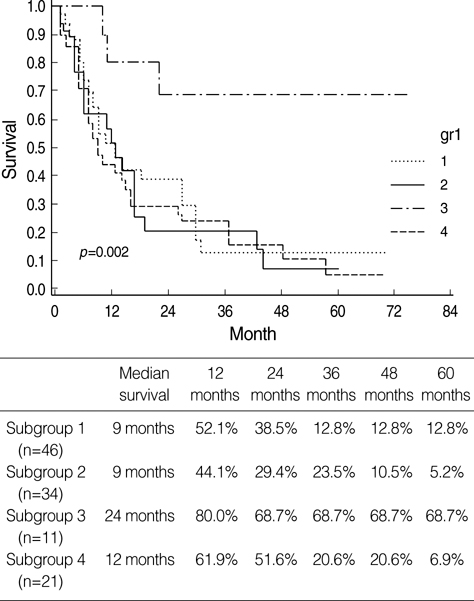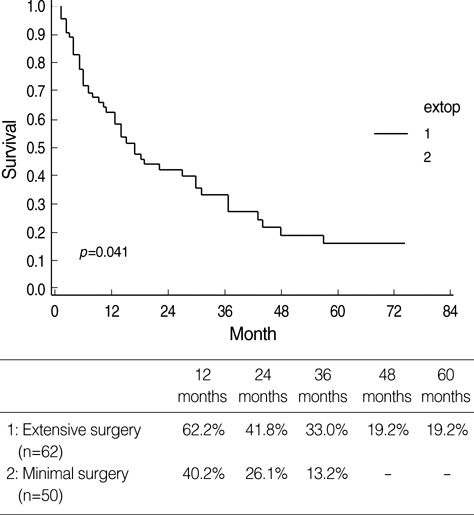J Korean Med Sci.
2009 Feb;24(1):114-119. 10.3346/jkms.2009.24.1.114.
Clinical Characteristics of Metastatic Tumors to the Ovaries
- Affiliations
-
- 1Department of Obstetrics and Gynecology, The Catholic University of Korea, Seoul, Korea. jspark@catholic.ac.kr
- 2Department of Pathology, The Catholic University of Korea, Seoul, Korea.
- 3Department of Medical Statistics, The Catholic University of Korea, Seoul, Korea.
- 4Department of Obstetrics and Gynecology, East-West Neo Medical Center, Kyunghee University, Seoul, Korea.
- KMID: 1794416
- DOI: http://doi.org/10.3346/jkms.2009.24.1.114
Abstract
- Approximately 5-30% of the ovarian cancers are metastatic malignancies. The prevalence of metastatic ovarian tumors varies with the incidence rates and spread patterns of primary malignancies. We evaluated the prevalence, pre- and postoperative characteristics of metastatic ovarian cancer in Korean women. We reviewed the records for 821 ovarian malignancies with pathological consultation from 1996- 2006 and recorded patient demographical, radiological, histopathological, and survival data. The study included 112 cases of histologically confirmed metastatic ovarian cancer. Metastatic ovarian cancer accounted for 13.6% of all ovarian malignancy, primarily arising from the gastrointestinal tract. The preoperative detection rate with imaging was 75%, and none of the radiological or serological features were useful for differential diagnosis. In multivariate analysis for prognostic variables, the only significant factor was the primary tumor site (p=0.004). Furthermore, extensive resection increased survival for some patients. The differential diagnosis of metastatic ovarian cancer can be problematic, so multiple diagnostic approaches are necessary. The extent of cytoreductive surgery for this type of tumor must be decided on a case-by-case basis.
Keyword
MeSH Terms
-
Adenocarcinoma/*diagnosis/*secondary/surgery
Adult
CA-125 Antigen/blood
Data Interpretation, Statistical
Diagnosis, Differential
Female
Gastrointestinal Neoplasms/diagnosis/pathology
Humans
Medical Records
Middle Aged
Ovarian Neoplasms/*diagnosis/*secondary/surgery
Ovariectomy
Prognosis
Retrospective Studies
Risk Factors
Survival Analysis
Figure
Cited by 2 articles
-
Mucinous Adenocarcinoma Involving the Ovary: Comparative Evaluation of the Classification Algorithms using Tumor Size and Laterality
Eun Sun Jung, Jeong Hoon Bae, Ahwon Lee, Yeong Jin Choi, Jong-Sup Park, Kyo-Young Lee
J Korean Med Sci. 2010;25(2):220-225. doi: 10.3346/jkms.2010.25.2.220.Assessment of different NEoplasias in the adneXa model for differentiation of benign and malignant adnexal masses in Korean women
Gina Nam, Sa Ra Lee, Kyungah Jeong, Sung Hoon Kim, Hye-Sung Moon, Hee Dong Chae
Obstet Gynecol Sci. 2021;64(3):293-299. doi: 10.5468/ogs.21012.
Reference
-
1. Young RH, Scully RE. Kurman RJ, editor. Metastatic tumors of the ovary. Blaustein's pathology of the female genital tract. 2002. 5th ed. New York: Springer;1063–1101.
Article2. McCluggage WG, Wilkinson N. Metastatic neoplasms involving the ovary: a review with an emphasis on morphological and immunohistochemical features. Histopathology. 2005. 47:231–247.
Article3. Yada-Hashimoto N, Yamamoto T, Kamiura S, Seino H, Ohira H, Sawai K, Kimura T, Saji F. Metastatic ovarian tumors: a review of 64 cases. Gynecol Oncol. 2003. 89:314–317.
Article4. Moore RG, Chung M, Granai CO, Gajewski W, Steinhoff MM. Incidence of metastasis to the ovaries from nongenital tract primary tumors. Gynecol Oncol. 2004. 93:87–91.
Article5. Ayhan A, Guvenal T, Salman MC, Ozyuncu O, Sakinci M, Basaran M. The role of cytoreductive surgery in nongenital cancers metastatic to the ovaries. Gynecol Oncol. 2005. 98:235–241.
Article6. Khunamornpong S, Suprasert P, Chiangmai WN, Siriaunkgul S. Metastatic tumors to the ovaries: a study of 170 cases in northern Thailand. Int J Gynecol Cancer. 2006. 16:Suppl 1. 132–138.
Article7. Antila R, Jalkanen J, Heikinheimo O. Comparison of secondary and primary ovarian malignancies reveals differences in their pre- and perioperative characteristics. Gynecol Oncol. 2006. 101:97–101.
Article8. Brown DL, Zou KH, Tempany CM, Frates MC, Silverman SG, McNeil BJ, Kurtz AB. Primary versus secondary ovarian malignancy: imaging findings of adnexal masses in the Radiology Diagnostic Oncology Group study. Radiology. 2001. 219:213–218.
Article9. Alcázar JL, Galán MJ, Ceamanos C, García-Manero M. Transvaginal gray scale and color Doppler sonography in primary ovarian cancer and metastatic ovarian tumors to the ovary. J Ultrasound Med. 2003. 22:243–247.10. Choi HJ, Lee JH, Seo SS, Lee S, Kim SK, Kim JY, Lee JS, Park SY, Kim YH. Computed tomography findings of ovarian metastases from colon cancer: comparison with primary malignant ovarian tumors. J Comput Assist Tomogr. 2005. 29:69–73.11. Koyama T, Mikami Y, Saga T, Tamai K, Togashi K. Secondary ovarian tumors: spectrum of CT and MR features with pathologic correlation. Abdom Imaging. 2007. 32:784–795.
Article12. Kim HK, Heo DS, Bang YJ, Kim NK. Prognostic factors of Krukenberg's tumor. Gynecol Oncol. 2001. 82:105–109.
Article13. Kikkawa F, Ino K, Nomura S, Ishikawa H, Kuzuya K, Yamamuro O, Kobayashi I, Kawai M, Mizutani S. Prognostic factors of secondary ovarian carcinoma. Oncology. 2002. 63:124–129.
Article14. Eitan R, Gemignani ML, Venkatraman ES, Barakat RR, Abu-Rustum NR. Breast cancer metastatic to abdomen and pelvis: role of surgical resection. Gynecol Oncol. 2003. 90:397–401.
Article15. Cheong JH, Hyung WJ, Chen J, Kim J, Choi SH, Noh SH. Survival benefit of metastasectomy for Krukenberg tumors from gastric cancer. Gynecol Oncol. 2004. 94:477–482.
Article16. Tserkezoglou A, Kontou S, Hadjieleftheriou G, Apostolikas N, Vassilomanolakis M, Sikiotis K, Salamalekis E, Tseke P, Magiakos G. Primary and metastatic ovarian cancer in patients with prior breast carcinoma. Pre-operative markers and treatment results. Anticancer Res. 2006. 26:2339–2344.17. Stat bite: Age-specific incidence and mortality rates for ovarian cancer, 1998-2002. J Natl Cancer Inst. 2006. 98:511.18. Prat J. Ovarian carcinomas, including secondary tumors: diagnostically challenging areas. Mod Pathol. 2005. 18:S99–S111.
Article19. Dennis JL, Hvidsten TR, Wit EC, Komorowski J, Bell AK, Downie I, Mooney J, Verbeke C, Bellamy C, Keith WN, Oien KA. Markers of adenocarcinoma characteristic of the site of origin: development of a diagnostic algorithm. Clin Cancer Res. 2005. 11:3766–3772.
Article20. GLOBOCAN 2002 cancer incidence. Mortality and prevalence worldwide. 2002. IARC CancerBase.21. Bae JH, Lee JM, Ryu KS, Lee YS, Park YG, Hur SY, Ahn WS, Namkoong SE. Treatment of ovarian cancer with paclitaxel- or carboplatin-based intraperitoneal hyperthermic chemotherapy during secondary surgery. Gynecol Oncol. 2007. 106:193–200.
Article22. Tong SY, Lee YS, Park JS, Bae SN, Lee JM, Namkoong SE. Clinical analysis of synchronous primary neoplasms of the female reproductive tract. Eur J Obstet Gynecol Reprod Biol. 2008. 136:78–82.
Article
- Full Text Links
- Actions
-
Cited
- CITED
-
- Close
- Share
- Similar articles
-
- A Case of Metastatic Ovarian Cancer Arising in Plasma Cell Leukemia
- Clinical Characteristics of Colorectal Carcinoid Tumors
- Mucinous Adenocarcinoma Involving the Ovary: Comparative Evaluation of the Classification Algorithms using Tumor Size and Laterality
- A case of advanced gynecologic pelvic tumors showing the diagnostic utility of HPV analysis
- Clinical Characteristics of Metastatic Tumors to the Ovaries



